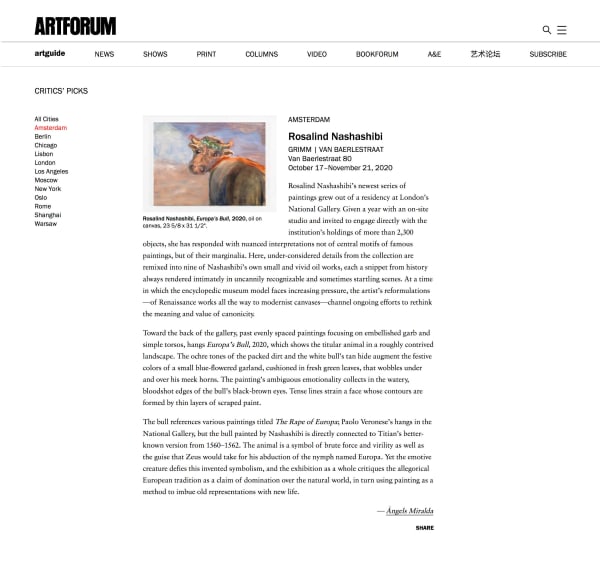Rosalind Nashashibi
GRIMM is pleased to present a new exhibition with Rosalind Nashashibi, opening at our Van Baerlestraat gallery in Amsterdam. This is the artists second solo exhibition at the gallery and her first solo exhibition at GRIMM Amsterdam.
Rosalind Nashashibi extracts elements from historic painting and imbues them with new significance and expressiveness, often in combination with autobiographical details. Nashashibi's free and vivid color palette, and the intimate physical presence of her works give them an openness, in a way that relates to the everyday language between close relations, unencumbered by convention and subject to a more direct kind of understanding.
Her new body of work has taken shape while Nashashibi has been completing a year-long residency at the National Gallery of London. During this period paintings by Uccello, Titian, Gauguin and Bonnard, have become points of inquiry from which the artist has drawn connections and new directions of departure in her practice. Of particular interest to Nashashibi is the way in which events-whether historical moments or mundane occurrences-can be depicted to allow space for changing, unfixed meaning.
Like her films, Nashashibi's paintings operate on the level of subjective and embodied experience, legs or red balustrades bracket areas that become emptied out arenas or pools of potential. Animals and human subjects appear in a non- located background, where their significance can be explored by other signs, such as animals or fruit or pattern. She uses framing devices and cropping that block the viewer's total understanding of her subjects - forms are doubled, and images are overlaid in such a way that situates the viewer within the picture, rather than as an observer or witness to a larger narrative.
In a painting of a fuchsia horse, titled Jump to Conclusions, she references The Battle of San Romano (1435-1460) by Paolo Uccello, recasting the horse as her heroic subject and obscuring its rider except for an outstretched leg. In another work, Untitled (PG), Paul Gauguin is depicted hiding behind a striped missionary dress. Nashashibi has pulled both the image of the dress and the bust of Gauguin from two of the artist's iconic paintings. Although the referent nature of this and other works invites complex discussions, particularly where historical conventions are cast in relief to our current moment, Nashashibi’s paintings remain open-ended. Malvolio, titled after William Shakespeare’s publicly shamed character from Twelfth Night, is painted so that only the figure’s shins are visible, a recurring compositional arrangement in Nashashibi’s oeuvre. This places the viewer in a position to look through the figure’s legs, and through their body, as if it were a portal. In Verso Nashashibi refers to the opposite side of a work of art, not seen when it is displayed. Here a woman’s back has been boldly simplified; a horizontal stroke marks the waistline of her dress, and further, it is combined with a vertical line to form the shape of a cross dividing her torso and the canvas. This intimate, cropped frame is at once sensuous and confining, a combination easily tipped into either of these directions.
Opening day: Saturday 17 October
Please reserve a time slot:
12:00 | 12:30 | 13:00 | 13:30 | 14:00 | 14:30 | 15:00 | 15:30 | 16:00 | 16:30 | 17:00 | 17:30








